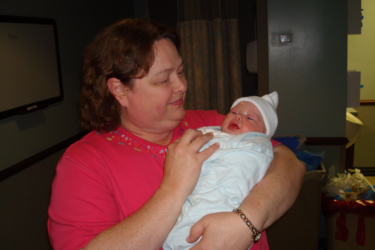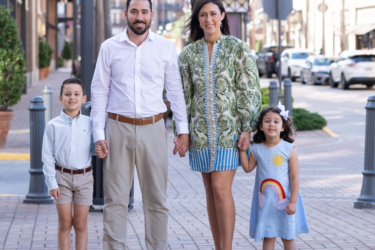
The Unfinished Family: Struggling with Secondary Infertility
I bought a yellow shirt that read, “I’m a Big Sister!” in a rainbow-glitter font. My daughter was barely two years old, and I knew that having a second child might not happen immediately. So, to be on the safe side, I bought the shirt in a size 4T. Sure, the top might be a little big on her, but it would definitely fit her when we were ready to announce a new addition to the family. The buying of that shirt symbolized mine and my husband’s desire to grow our family, to offer our daughter a sibling to tell secrets to, to bring another perfect human into the world. I never imagined that today, years later, the tags would remain on the unworn yellow shirt.
Having my daughter in 2010 was easy for me in that she was a happy surprise; I never had to go through the demanding process of someone trying to conceive, or “TTC” on pregnancy blogs and websites. When we later made the decision to add to our family, I downloaded a highly-rated fertility app to log my daily stats: weight, mood, any bleeding, dates and times of sexual activity, and basal body temperature. After three months of tracking my cycle, I noticed that there was no discernable pattern. At 31, I figured I’d better make an appointment with my longtime OB/GYN to figure out what was happening with my body. Never in a million years did I imagine I would be labeled “infertile.”
Secondary Infertility
According to The National Infertility Association, RESOLVE, secondary infertility is defined as “the inability to become pregnant, or to carry a pregnancy to term, following the birth of one or more biological children. The birth of the first child does not involve any assisted reproductive technologies or fertility medications.” After seeing two area fertility specialists, along with submitting myself to countless ultrasounds and lab work, I was more than dumbfounded by this diagnosis. I always thought of infertility as meaning a couple had trouble conceiving their first child. How could it be that I delivered a perfectly healthy baby girl at the age of 28, but by the age of 31, be unable to have another? Even though I had never heard of “secondary infertility,” 12 percent of women in the United States are affected by it. In fact, secondary infertility accounts for more than half of all U.S. infertility cases.
Claudene Cockrum, an area high school teacher, recounts a story not very different from mine and millions of other women. “I was 24 when I had my son, Jack. We weren’t ‘trying’ so to speak, but we had been married for a couple of years, so we were thrilled. Two years later, we decided to try again.” After two years of charting her irregular cycles and hoping for a second child, Claudene and her husband sought the help of a reproductive endocrinologist, commonly referred to as “fertility specialist.” Claudene then underwent two years of medical intervention, but after the emotional roller coaster of being alternately hopeful and devastated, she decided to focus on raising her nine-year-old son.
Why me?
In Claudene’s case, Polycystic Ovarian Syndrome (PCOS) appeared to play a part in her secondary infertility. According to the physicians at the Fertility Institute in Baton Rouge, other causes of secondary infertility can be infection, failure to ovulate, blockage of the fallopian tubes, endometriosis, poor egg quality, or low sperm motility. But for most women diagnosed with secondary infertility, an exact cause will never be found.
Becky M. was 35 when she and her husband decided to have their second child. Since she had no trouble conceiving her first child at 31, she never imagined that she would have such difficulty getting and remaining pregnant. When a second child didn’t come quickly, Becky sought the help of fertility specialists. Despite the numerous tests and imaging done to detect a problem, none was ever found. “Nothing was actually wrong with either of us. We just felt dejected,” she shares.
What Now?
Treatment for secondary infertility is often what is offered for those with primary infertility: controlled ovarian hyperstimulation, artificial insemination, and in vitro fertilization. Many women undergo exploratory laparoscopic surgery to determine if endometriosis might be the culprit. The Fertility Institute in Baton Rouge notes that “when other treatment has failed to result in pregnancy, we recommend assisted reproductive technologies (ART). We believe that individualizing treatment for each couple is needed, rather than using one treatment for all.”
Treatments are tailored to the individual after many medical assessments are completed and family finances have been considered.
Invisible Infertility
In the 53 months I have prayed for another child, I have found struggles unique to couples coping with secondary infertility. Family, friends, coworkers, and even strangers see me out and about with a smiling, curly-headed little girl. It has happened more times than I care to remember that a well-meaning acquaintance offers up advice such as “you can’t have just one!”
And even more absurd and frequent, I hear “you have to have a boy now!” Each time I hear one of these comments, I feel a dull tugging in my chest. I want to cry out, “Don’t you know I want that?” I ask myself all the time what I did to deserve this fate. How do I explain to my daughter, who desperately wants a sibling, that she can’t have one?
Secondary infertility, much like primary infertility, can bring about intense feelings of inadequacy, wondering why the body doesn’t work correctly. It can be embarrassing when confronted with a well-intentioned comment from a stranger. But when trying to lean on friends who are going through primary infertility for support, the compassion can, at times, be lacking. I thought that I could find a kindred soul who understood my grief, but my desperation and devastation were often met with “you should be grateful for the one you have.” And God, I am! I am simultaneously embarrassed over my sadness of not being able to conceive again and angered by the accusation. Do other couples have multiple children because they were ungrateful for their first born? People see what is in front of them—a child. They never see what’s still missing.
Journey’s End
Many women will find that ART provides them with the opportunity to expand their family. Claudene, having given up on treatments, spontaneously conceived her daughter, Emma, nine years after the birth of her son. For Becky, the use of Clomid (an ovarian hyperstimulant) gave her a second child after many heartbreaking years of failed treatments. But they are the exception, not the rule. I know how my story ends. I have run out of time. I have no more “maybe next month” hopes. Endometriosis, often a factor in infertility, has claimed my reproductive organs.
Women experiencing secondary infertility need to know that they are not alone, but their struggles are often unseen. It is completely appropriate to be angry, sad, and confused about this diagnosis. I know I am. RESOLVE recommends seeing an infertility counselor to talk through complicated emotions. Those with secondary infertility need to talk to others for support. For parents who have not undergone the pain of infertility, don’t judge the feelings or reactions of those who have. Don’t offer empty lines of advice like, “Just relax!” But please, lend a compassionate ear because we are just trying to find a way to come to terms with having an “unfinished family.” ■





